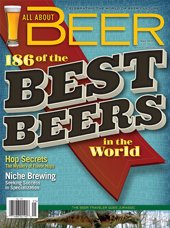A Perfect Marriage
The original Oktoberfest celebrated the marriage of Crown Prince Ludwig I of Bavaria and Princess Therese of Saxony-Hildburghausen. The event occurred on October 12, 1810 and all residents of Munich were invited to the countryside to join the gala. The festivities last for five days, and ended with a horse race.
The Oktoberfestbiers that were served at the festival were actually Märzenbier, and were the indigenous Munich dunkels, all of which were supplied by the established local breweries. This all changed in 1872 when Josef Sedlmayr of Franziskaner (today part of Spaten) introduced an amber lager to Oktoberfest.
He first made this beer in 1871, using the Viennese recipe as a template, deemed it a rousing success, and made it again in March 1872 for consumption in the autumn. He called it Ur-Märzen (original Märzen). When the beer supply ran low at the 1872 Oktoberfest, Sedlmayr made his Ur-Märzen available to the thirsty festers. He unknowingly introduced what has become the modern Märzen, and the staple at all Oktoberfest celebrations shortly thereafter, as the style was hastily adopted by many of the other Munich breweries.
Today’s festival biers are ceremoniously tapped as they have always been, but it should be noted that some are decidedly golden in color. Since the 1970s, as Oktoberfest has become more popular and drawn more attendees from around the world, the brews were reformulated to appease the shifting clientele. Those burnished gold versions are more similar to Munich helles, with a tad more heft. Still malty, they lack the succulent toasty character of darker Vienna and Munich style malts found in the bright copper examples. The latter are the originals: they are most likely to be exported and accessible, and are more associated with the evolution of the style. German breweries often make both interpretations: the golden for domestic consumption, and the copper for export.
Rich Tradition
Märzen/Oktoberfest beer symbolically captures the autumnal shift of seasons. The bright copper-orange color comes from the use of toasted Vienna and Munich varieties of malted barley. Kilned at a slightly higher temperature than golden pilsner malt, Vienna and Munich varieties lend not only amber color to the wort, but a toasty, melanoidin-rich flavor and aroma, soft malt sweetness, palpable mouthfeel and slight spiciness.
Vienna malt is less robust in this respect than Munich. The effect of this kilning is dramatic when compared to a helles for example, a brew made with almost entirely with pilsner malt. Superb wort can be made with nearly any combination of these malts, including pilsner, but it is essential to include a measure of Vienna, Munich, or both. A recipe heavy on Munich malt would create a more juicy malt character, with one leaning on Vienna malt a bouncier, spicy version.
Recall that Dreher’s pioneering contribution to the beer world was his newly-fashioned amber malt that he coupled with his conversion to bottom-fermentation. He demonstrated that skilled maltsters could make a precisely-kilned house malt for a specific type of beer. That innovation was and still is the basic formulation in an exceptional Märzen/Oktoberfest.
Hop rates are subdued, but there is no mistaking the noble German aroma and flavor. The emergent brew is an elegant display of clean maltiness that comes in at 5.5 to 6.0 percent ABV. New World interpretations seldom stray far from their Germanic ancestors, and are generally seasonal brews. Imported or domestic, they may carry any one or a combination of the designations on the label.
Many find solace from the doldrums of winter in a strong brew, or relief from the summer heat in a more lilting thirst-quencher. Fall is yet another time to savor an appropriate brew, one that provides something in between. For many, autumn is the best time of the year, serving up impeccable weather, reflection and ambiance, and to those, it also offers a most flawless seasonal beer in Märzen/Oktoberfest.














they seem to work for me. can you tell me what browser you are using?